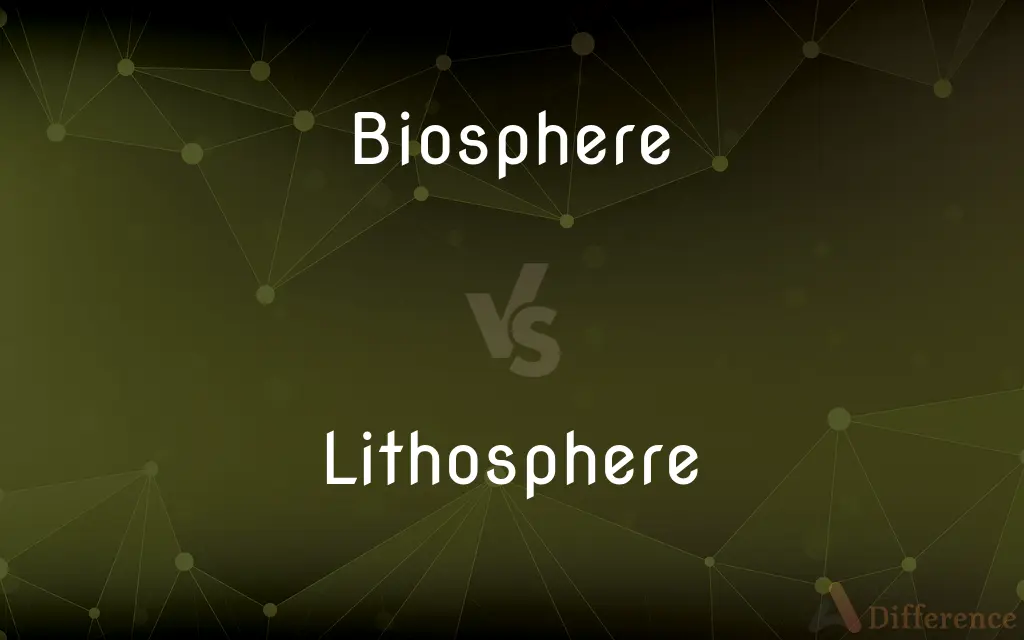Biosphere vs. Lithosphere — What's the Difference?
Edited by Tayyaba Rehman — By Maham Liaqat — Updated on April 26, 2024
The biosphere encompasses all ecosystems and living organisms on Earth, interacting with elements of the atmosphere, hydrosphere, and lithosphere. The lithosphere consists of Earth's crust and upper mantle, primarily influencing geological activitvities.

Difference Between Biosphere and Lithosphere
Table of Contents
ADVERTISEMENT
Key Differences
The biosphere refers to the global ecological system integrating all living beings and their relationships, including their interactions with the elements of the lithosphere, atmosphere, and hydrosphere; whereas the lithosphere is the rigid outer layer of Earth, important for geological aspects like tectonics and erosion.
Life within the biosphere depends on cycles and energy flows that encompass various environments from aquatic to terrestrial; on the other hand, the lithosphere provides the physical ground or base, consisting mostly of rocks and soil, crucial for supporting these life forms.
The biosphere is dynamic and includes biological processes such as photosynthesis, respiration, and decomposition, which are essential for sustaining life on Earth; in contrast, the lithosphere is characterized by geological processes like volcanic activities, mountain formation, and earthquakes.
Changes in the biosphere can have direct impacts on climate and ecosystems, indicating its integral role in Earth's sustainability; whereas changes in the lithosphere, such as tectonic movements, can alter geographical and climatic conditions significantly, impacting the biosphere indirectly.
The study of the biosphere often focuses on environmental and ecological concerns, such as biodiversity and conservation; meanwhile, the study of the lithosphere is centered around geology, minerals, and earth sciences, focusing on Earth's physical structure and processes.
ADVERTISEMENT
Comparison Chart
Definition
All living organisms and their ecological interactions
Earth's crust and upper mantle, geological features
Components
Plants, animals, microorganisms
Rocks, minerals, soils
Primary Processes
Biological (photosynthesis, respiration)
Geological (tectonics, erosion)
Impact on Earth
Affects climate, ecosystems
Influences Earth's physical surface and structure
Scientific Focus
Ecology, environmental science
Geology, earth sciences
Compare with Definitions
Biosphere
The global sum of all ecosystems.
The Amazon Rainforest is a vital part of the Earth's biosphere.
Lithosphere
Studies often focus on minerals and rock cycles.
Mining operations extract valuable minerals from the lithosphere.
Biosphere
Integral for studying ecological and environmental sustainability.
Conservation efforts aim to protect the biosphere’s biodiversity.
Lithosphere
Comprises the rigid outer part of the earth.
The lithosphere includes the Earth's crust and part of the upper mantle.
Biosphere
Influenced by and interacts with other earth systems.
The biosphere is affected by atmospheric changes like global warming.
Lithosphere
Supports the physical foundation for ecosystems.
Soil from the lithosphere is essential for plant growth.
Biosphere
Involves all living organisms and their ecological relationships.
Coral reefs and their diverse species interactions illustrate biosphere complexity.
Lithosphere
Essential for understanding geological activities and features.
The formation of the Himalayas is a result of lithospheric movements.
Biosphere
Focuses on life's dependency on natural resources and conditions.
Water cycles within the biosphere are crucial for all life forms.
Lithosphere
Subject to processes like tectonics and volcanic activity.
Earthquakes are a direct result of tectonic shifts within the lithosphere.
Biosphere
The biosphere (from Greek βίος bíos "life" and σφαῖρα sphaira "sphere"), also known as the ecosphere (from Greek οἶκος oîkos "environment" and σφαῖρα), is the worldwide sum of all ecosystems. It can also be termed the zone of life on Earth.
Lithosphere
A lithosphere (Ancient Greek: λίθος [líthos] for "rocky", and σφαίρα [sphaíra] for "sphere") is the rigid, outermost shell of a terrestrial-type planet or natural satellite. On Earth, it is composed of the crust and the portion of the upper mantle that behaves elastically on time scales of thousands of years or greater.
Biosphere
The part of the earth and its atmosphere in which living organisms exist or that is capable of supporting life.
Lithosphere
The outer part of the earth, consisting of the crust and upper mantle, about 100 kilometers (62 miles) thick.
Biosphere
The living organisms and their environment composing the biosphere.
Lithosphere
(geology) The rigid, mechanically strong, outer layer of the Earth; divided into twelve major plates.
Biosphere
The part of the Earth and its atmosphere capable of supporting life.
Lithosphere
The solid earth as distinguished from its fluid envelopes, the hydrosphere and atmosphere.
Biosphere
The totality of living organisms and their environment.
Lithosphere
The solid part of the earth consisting of the crust and outer mantle
Biosphere
The regions of the surface and atmosphere of the Earth (or other planet) where living organisms exist
Common Curiosities
What defines the biosphere?
The biosphere encompasses all living organisms and their ecological systems on Earth.
How is the biosphere important to Earth’s environment?
The biosphere plays a crucial role in regulating atmospheric conditions and supporting life through various ecosystems.
What processes are characteristic of the lithosphere?
Characteristic processes include plate tectonics, mountain building, and erosion.
What is the significance of the lithosphere in natural disasters?
The lithosphere’s dynamics, like fault movements, often cause natural disasters such as earthquakes and tsunamis.
What are the main components of the lithosphere?
The lithosphere is primarily made up of Earth's crust and the upper part of the mantle.
How do human activities impact the biosphere?
Human activities like deforestation and pollution can drastically alter and damage the biosphere.
How does the biosphere interact with the lithosphere?
The biosphere depends on the lithosphere for resources like soil and water, which are essential for life.
Can changes in the lithosphere affect the biosphere?
Yes, geological changes in the lithosphere, such as volcanic eruptions, can significantly impact ecological systems in the biosphere.
Why is studying the lithosphere important?
Studying the lithosphere helps in understanding Earth's physical structure, mineral resources, and geological history.
What role does the biosphere play in climate change?
The biosphere affects and is affected by climate change, particularly through the carbon cycle and forest ecosystems.
Share Your Discovery

Previous Comparison
Regioselectivity vs. Stereoselectivity
Next Comparison
Toke vs. TakeAuthor Spotlight
Written by
Maham LiaqatEdited by
Tayyaba RehmanTayyaba Rehman is a distinguished writer, currently serving as a primary contributor to askdifference.com. As a researcher in semantics and etymology, Tayyaba's passion for the complexity of languages and their distinctions has found a perfect home on the platform. Tayyaba delves into the intricacies of language, distinguishing between commonly confused words and phrases, thereby providing clarity for readers worldwide.














































